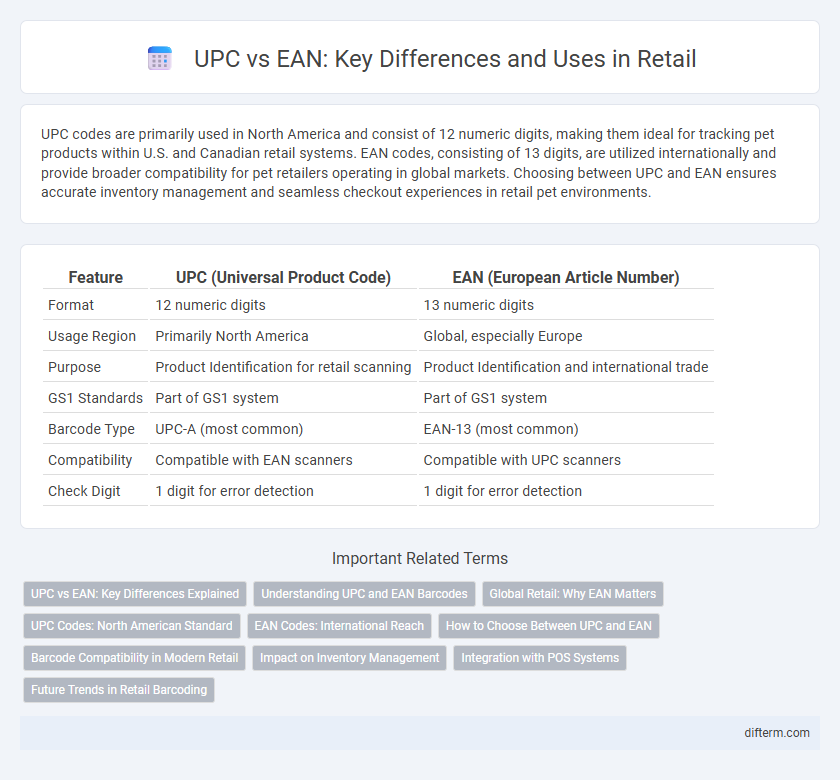UPC codes are primarily used in North America and consist of 12 numeric digits, making them ideal for tracking pet products within U.S. and Canadian retail systems. EAN codes, consisting of 13 digits, are utilized internationally and provide broader compatibility for pet retailers operating in global markets. Choosing between UPC and EAN ensures accurate inventory management and seamless checkout experiences in retail pet environments.
Table of Comparison
| Feature | UPC (Universal Product Code) | EAN (European Article Number) |
|---|---|---|
| Format | 12 numeric digits | 13 numeric digits |
| Usage Region | Primarily North America | Global, especially Europe |
| Purpose | Product Identification for retail scanning | Product Identification and international trade |
| GS1 Standards | Part of GS1 system | Part of GS1 system |
| Barcode Type | UPC-A (most common) | EAN-13 (most common) |
| Compatibility | Compatible with EAN scanners | Compatible with UPC scanners |
| Check Digit | 1 digit for error detection | 1 digit for error detection |
UPC vs EAN: Key Differences Explained
UPC (Universal Product Code) and EAN (European Article Number) are two widely used barcoding systems essential in retail for product identification. UPC codes consist of 12 numerical digits primarily used in North America, while EAN codes contain 13 digits and are prevalent internationally, especially in Europe. The key differences lie in their geographic usage, length, and number format, impacting scanning compatibility and inventory management.
Understanding UPC and EAN Barcodes
UPC (Universal Product Code) and EAN (European Article Number) barcodes are essential for retail inventory management and point-of-sale systems. UPC codes typically contain 12 numerical digits used primarily in the United States and Canada, while EAN codes have 13 digits and are widely used internationally, including Europe. Both barcode types encode product information that enables efficient scanning, tracking, and sales processing across retail platforms.
Global Retail: Why EAN Matters
EAN codes are essential in global retail as they enable standardized product identification across international markets, facilitating efficient supply chain management and accurate inventory tracking. Unlike UPC codes, which are predominantly used in the United States and Canada, EAN codes support seamless cross-border commerce by accommodating a wider range of digits and integrating with global databases. Retailers and manufacturers benefit from EAN's universal acceptance, reducing errors and improving product visibility worldwide.
UPC Codes: North American Standard
UPC codes serve as the primary barcode standard in North America, uniquely identifying retail products through a 12-digit numeric format. These codes facilitate efficient inventory management and point-of-sale transactions by encoding manufacturer and product information. As a subset of the Global Trade Item Number (GTIN) system, UPC ensures compatibility with international EAN standards while catering specifically to regional retail requirements.
EAN Codes: International Reach
EAN codes, or International Article Numbers, facilitate global retail operations by enabling standardized product identification across multiple countries. Unlike UPC codes, which are primarily used in North America, EAN codes are recognized in over 140 countries, supporting international trade and supply chain efficiency. Retailers benefit from EAN codes through improved inventory management, seamless point-of-sale transactions, and enhanced compatibility with global e-commerce platforms.
How to Choose Between UPC and EAN
Choosing between UPC and EAN depends primarily on your target market and product distribution scope. UPC codes are predominantly used in North America, while EAN codes are essential for international retail and global supply chains. Consider your geographic audience and retailer requirements to determine which barcode standard aligns best with your inventory management and point-of-sale systems.
Barcode Compatibility in Modern Retail
UPC and EAN barcodes are universally compatible in modern retail systems, enabling seamless product identification across global markets. Retailers utilize barcode scanners and inventory software optimized to read both UPC (primarily used in North America) and EAN (common internationally) formats, ensuring efficient stock management and checkout processes. This compatibility supports cross-border e-commerce and supply chain integration, enhancing operational efficiency and customer experience.
Impact on Inventory Management
UPC codes, predominantly used in North America, streamline inventory tracking by ensuring product consistency and reducing errors at the point of sale. EAN codes, widely adopted internationally, enhance inventory accuracy across global supply chains by providing a standardized identification system compatible with diverse retail platforms. Integrating UPC and EAN systems optimizes stock management, minimizes discrepancies, and improves real-time data analytics in retail operations.
Integration with POS Systems
UPC (Universal Product Code) and EAN (European Article Number) are both essential barcode formats for retail, with seamless integration into POS (Point of Sale) systems enhancing inventory management and sales tracking. Most modern POS systems support both UPC and EAN codes, enabling accurate product identification and smooth transaction processing across different markets. Choosing a barcode format compatible with the retailer's POS software ensures efficient scanning, reduced errors, and streamlined checkout experiences.
Future Trends in Retail Barcoding
Future trends in retail barcoding emphasize the integration of UPC and EAN systems with advanced technologies such as RFID and IoT for enhanced inventory management and real-time data analytics. The convergence of UPC and EAN codes supports global standardization, facilitating seamless international trade and supply chain transparency. Retailers are increasingly adopting AI-driven barcode scanning solutions to improve accuracy and efficiency in product identification and customer checkout experiences.
UPC vs EAN Infographic

 difterm.com
difterm.com